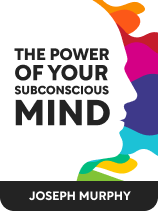

This article is an excerpt from the Shortform book guide to "The Power of Your Subconscious Mind" by Joseph Murphy. Shortform has the world's best summaries and analyses of books you should be reading.
Like this article? Sign up for a free trial here .
How does the subconscious mind work? What information does it store and how does it interact with the conscious mind?
Your subconscious mind is your passive mind. It’s always awake because it regulates all of your bodily functions, and it records and stores your every experience even when you’re not consciously paying attention. Over 90% of your brain’s activity takes place in your subconscious mind: It’s a reservoir of thoughts, feelings, and memories that lies beneath your conscious awareness.
In this article, we’ll explore how the subconscious mind works, according to Joseph Murphy.
Your Subconscious Mind Is Your Passive Mind
There is still much to be learned about how the subconscious mind works, but even in 1963, Murphy was right about its importance—neuroscientists have confirmed that 95% of your brain activity takes place beyond your conscious awareness, in your subconscious mind. Further, research reveals that your subconscious mind makes decisions about how you choose to feel or act before your conscious mind even perceives the need to make a decision.
So, how does the subconscious mind work?
Murphy claims that your subconscious mind passively accepts your habitual conscious thoughts without question. In other words, it doesn’t judge any of your conscious thoughts (in the same way that your computer doesn’t judge the documents you save onto your hard drive). All of the thoughts you think in your conscious mind filter down into your subconscious mind and leave an impression. The more often you think certain thoughts, the heavier the impression you leave on your subconscious mind.
According to Murphy, the way your conscious thoughts imprint upon and mold your subconscious mind determines your personality traits and how you respond to your life experiences. This is because your habitual thoughts train your subconscious mind to create associations and shortcuts between all of the thoughts, feelings, and experiences it has stored.
| Why Your Subconscious Mind Relies on Your Conscious Thoughts to Create Shortcuts Research supports Murphy’s claim that your conscious thoughts train your subconscious mind to create shortcuts. Your subconscious mind is an unlimited memory bank that permanently stores your every life experience: As Murphy describes, everything you experience is imprinted in this area of your brain. This memory bank processes 4 million bits (a measure of data transfer) per second and includes both significant and insignificant experiences, such as how you felt the first time you fell in love and the many hours you’ve wasted on Netflix. According to one researcher, by the time you’re 21, your subconscious mind has stored more than 100 times the contents of the entire Encyclopedia Britannica. According to psychologists, your conscious mind relies on this memory bank to access the information you need on a moment-by-moment basis. For example, when you need to remember the name of someone you’ve just bumped into, you retrieve the name from where it’s been stored in your subconscious mind. Since this memory bank is so full of information, it needs to create shortcuts so that it can quickly sift through everything it has stored and retrieve the information you need. Therefore, it relies on your conscious thoughts to categorize everything it stores in terms of how relevant it is to your habitual way of thinking. For example, your subconscious mind may classify your best friend’s name as something important to remember, since you consciously speak with and interact with this person regularly. However, it’s unlikely to give the name of a stranger the same level of importance and precedence in its memory bank. |
To clarify how your conscious thoughts mold your subconscious mind, we’ll first explore the process that enables you to use shortcuts to perform certain tasks automatically. Then, we’ll explore how, according to Murphy, this same process influences your feelings, behaviors, and personality.
Your Subconscious Mind Learns From Repetition
Murphy explains that you’re able to perform tasks without having to apply conscious thought, such as riding a bike or getting dressed, because the impressions your habitual conscious thoughts make condition your subconscious mind to act automatically. When you’re learning how to do something new, you have to focus on what you’re doing and apply conscious effort in order to do it right. The more you practice this skill, the easier it becomes for you to perform the task without conscious effort. This is because your subconscious mind learns how to perform the task and takes control so that you can perform it automatically.
| Why Repetition Leads to Automatic Behavior Since The Power of Your Subconscious Mind’s publication in 1963, neuroscientists have developed the ability to observe how learning occurs at the molecular level—they can see what goes on inside our brains when we’re engaged in learning something new. While this research doesn’t specifically comment on the part that your subconscious mind plays in this process, it does include details about the impact of your short-term and long-term memory on learning, which are both stored in your subconscious mind. The more you learn, the more you change the physical structure of your brain by strengthening specific neural pathways. Here’s a very brief overview of neural pathways: The brain consists of a dense network of pathways consisting of neurons. Synapses allow sensory information to be transmitted through this network of neurons. This sensory information is stored in your short-term memory while your brain processes it by comparing it to the memories you’ve stored in your long-term memory (everything in your subconscious mind). This process determines whether the new sensory information is kept or discarded. Neuroscientists believe that your memory and recall rely upon the relationship that your neurons have with each other. The stronger the relationship (the more frequently these neurons interact with each other), the stronger your ability to remember and recall what you need to do. This is because strong neural pathways heighten the transmission speed of information and allow you to effortlessly recall the information you need. This is why you can perform your routine tasks without conscious effort. Every time you learn something new, you need to form new neural connections within the brain—this requires conscious effort and attention. When you attempt to do something new, your brain has to work much harder because you haven’t yet developed the specific neural pathways—the neurons required to achieve the task haven’t developed a relationship so their communication is inefficient. However, the more you practice, the more you strengthen your neural pathways and encourage the required neurons to interact and develop strong pathways. Stronger neural pathways allow your subconscious mind to take over the task without your conscious mind’s involvement. |
Your Subconscious Mind Forms Conclusions About Your Beliefs
In the same way that practicing a new skill conditions you to carry it out automatically, your habitual conscious thoughts condition your subconscious mind to identify and classify everything it perceives in a specific way. For example, if you habitually think that dogs are a threat, your subconscious mind classifies every dog it perceives as a threat. Murphy claims that this is because your subconscious mind forms conclusions about what your overarching beliefs are based on your habitual conscious thoughts. It then automatically relies upon these overarching beliefs to process and catalog all of the information it records.
The following examples illustrate how your subconscious mind creates conclusions from your overarching beliefs:
Example #1: You habitually think that “men are distrustful” and imprint this upon your subconscious mind. Your thoughts turn into a belief—your subconscious mind concludes that every man you think of or see is distrustful: “Men are distrustful, this is a man, therefore he is distrustful.”
Example #2: You habitually think about how uncomfortable you feel around strangers and imprint this into your subconscious mind. These thoughts turn into a belief so your subconscious mind concludes that every new person threatens your sense of safety and comfort: “Strangers make me uncomfortable, this is a new person, therefore I should feel uncomfortable.”

———End of Preview———
Like what you just read? Read the rest of the world's best book summary and analysis of Joseph Murphy's "The Power of Your Subconscious Mind" at Shortform .
Here's what you'll find in our full The Power of Your Subconscious Mind summary :
- How your subconscious mind creates your life experiences
- How to improve your life experiences by using your conscious mind to influence your subconscious
- Why we're all designed to experience happiness







The preview misses the essence of what Joseph Murphy is saying, i.e., the subconscious mind is not just a computer which contains retrievable information, but it is first and foremost, a creative power, or agency.
Im suggesting that you use the term “for example ” when you speak of the millions of data portion in your article.